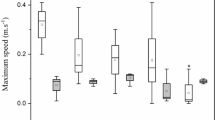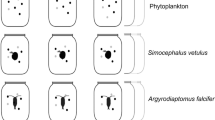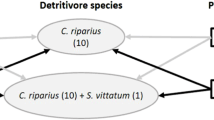Abstract
Predator–prey relationships are determining factors in sustaining community structure but xenobiotics, including pesticides, have the potential to alter them, causing imbalances at the ecosystem level. Although invertebrate predation on zooplankton is of high importance in shallow lakes, there is still little information regarding disturbances on this trophic interaction. This work assessed the potential effects of a chlorpyrifos-based pesticide (CLP) on the interaction between prawns Macrobrachium borellii and cladocerans Ceriodaphnia dubia, taking into account prey densities, specific time of exposure and contamination level. The analysis was focused on the specific sensitivity of both species and, especially, on the predation rate of M. borellii on C. dubia. The latter was evaluated through different treatments that combined predator and/or prey exposure to the insecticide, before (lapse of 12 h) or during the interaction. Under low prey density, when prawns were previously exposed to the insecticide, their consumption rate was lower than that of controls. Conversely, when cladocerans or both species were previously exposed, the prawns’ feeding rate was higher. Under high prey density, there were no substantial differences among treatments. Comparatively, cladocerans were significantly more consumed when the exposure of both species was performed before rather than during the interaction. From the results obtained, it can be assumed that the trophic interaction under study is sensitive to CLP and that individual density and specific time of exposure are important variables to be considered in similar studies in order to obtain realistic results.




Similar content being viewed by others
References
Agostinho M, Moreira-Santos M, Ribeiro R (2012) A freshwater amphipod toxicity test based on postexposure feeding and the population consumption inhibitory concentration. Chemosphere 87:43–48
Anguiano OL, Castro C, Venturino A, Ferrari A (2012) Acute toxicity and biochemical effects of azinphos methyl in the amphipod Hyalella curvispina. Environ Toxicol 139(4):239–243
ATSDR, Agency for Toxic Substances and Disease Registry (1997) Toxicological profile for chlorpyrifos. Atlanta, Georgia
Bailey HC, Miller JL, Miller MJ, Wiborg LC, Deanovic L, Shed T (1997) Joint acute toxicity of Diazinon and chlorpyrifos to Ceriodaphnia dubia. Environ Toxicol Chem 16(11):2304–2308
Baldwin DH, Spromberg JA, Collier TK, Scholz NI (2009) A fish of many scales: extrapolating sublethal pesticide exposures to the productivity of wild salmon populations. Ecol Appl 19:2004–2015
Brooks AC, Gaskell PN, Maltby LL (2009) Sublethal effects and predator–prey interactions: implications for ecological risk assessment. Environ Toxicol Chem 28(11):2449–2457
Buser CC, Spaak P, Wolinska J (2012) Disease and pollution alter Daphnia taxonomic and clonal structure in experimental assemblages. Freshw Biol 57:1865–1874
Collins PA, Paggi JC (1998) Feeding ecology of Macrobrachium borellii (Nobili) (Decapoda: Palaemonidae) in the flood valley of the River Paraná, Argentina. Hydrobiologia 362:21–30
Collins PA, Petriella AM (1996) Crecimiento y supervivencia del camarón Macrobrachium borellii (Decapoda: Palaemonidae) alimentado con dietas artificiales. Neotropica 42:3–8
Collins PA, Williner V, Giri F (2007) Littoral communities. Macrocrustaceans. In: Iriondo MH, Paggi JC, Parma MJ (eds) The middle paraná river: limnology of a subtropical wetland. Springer, Berlin, pp 277–301
CONICET, Consejo Nacional de Ciencia y Técnica (2009) Informe: Evaluación de la información científica vinculada al glifosato en su incidencia sobre la salud humana y el ambiente. Buenos Aires, Argentina
Coors A, De Meester L (2008) Synergistic, antagonistic and additive effects of multiple stressors: predation threat, parasitism and pesticide exposure in Daphnia magna. J Appl Ecol 45:1820–1828
Dodson S, Hanazato T (1995) Commentary on effects of anthropogenic and natural organic chemicals on development, swimming behavior, and reproduction of Daphnia, a key member of aquatic ecosystems. Environ Health Perspect 103(4):7–11
Finney DJ (1971) Probit analysis. Cambridge University Press, London, p 333
Gonzales Sagrario MA, Balseiro E (2010) The role of macroinvertebrates and fish in regulating the provision by macrophytes of refugia for zooplankton in a warm temperate shallow lake. Freshw Biol 55(10):2153–2166
Guerritsen J, Strickler JR (1997) Encounter probabilities and community structure in zooplankton: a mathematical model. Can J Fish Res Board 34:73–82
Gutierrez MF, Gagneten AM, Paggi JC (2011) Microcrustaceans escape behavior as an early bioindicator of copper, chromium and endosulfan toxicity. Ecotoxicology 21(2):428–438
Gutierrez MF, Gagneten AM, Paggi JC (2012) Acute and behavioural sensitivity of Mesocyclops longisetus to Atrazine and Endosulfan formulations under predation pressure. Water Air Soil Pollut 224(1) (Online). doi:10.1007/s11270-012-1375-2
Hanazato T (2001) Pesticide effects on freshwater zooplankton: an ecological perspective. Environ Pollut 112(1):1–10
Ingerman RL, Bencic DC, Verrell P (2002) Methoxychlor alters the predator prey relationship between dragonfly naiads and salamander larvae. Bull Environ Contam Toxicol 68:771–778
Jergentz S, Pessacq P, Mugni H, Bonetto C, Schulz R (2004) Linking in situ bioassays and dynamics of macroinvertebrates to assess agricultural contamination in streams of the Argentine pampa. Ecotoxicol Environ Saf 59(2):133–141
Jergentz S, Mugni H, Bonetto C, Schulz R (2005) Assessment of insecticide contamination in runoff and stream water of small agricultural streams in the main soybean area of Argentina. Chemosphere 61:817–826
José de Paggi S, Paggi JC (2007) Littoral communities. Zooplankton. In: Iriondo MH, Paggi JC, Parma MJ (eds) The middle Paraná River: limnology of a subtropical wetland. Springer, Berlin, pp 229–249
José de Paggi S, Paggi JC (2008) Hydrological connectivity as a shaping force in the zooplankton community of two lakes in the Paraná River floodplain. Int Rev Hydrobiol 93(6):659–678
Junges CM, Peltzer PM, Lajmanovich RC, Attademo AM, Cabagna Zenklusen MC, Basso A (2012) Toxicity of the fungicide trifloxystrobin on tadpoles and its effect on fish–tadpole interaction. Chemosphere 87:1348–1354
Kenaga E (1982) Predictability of chronic toxicity from acute toxicity of chemicals in fish and aquatic invertebrates. Environ Toxicol Chem 1:347–358
Kovach J, Petzoldt C, Degnil J, Tette J (1992) A method to measure the environmental impacts of pesticides. N Y Food Life Sci Bull 139:1–8
Lampert W, Sommer U (1997) Limnoecology. Oxford University Press
Langer-Jaesrich M, Kienle C, Köhler H-R, Gerhardt A (2010) Impairment of trophic interactions between zebrafish (Danio rerio) and midge larvae (Chironomus riparius) by chlorpyrifos. Ecotoxicology 19:1294–1301
Loureiro C, Pereira JL, Pedrosa MA, Goncalves F, Castro BB (2013) Competitive outcome of Daphnia-Simocephalus experimental microcosms: salinity versus priority effects. PLoS One 8:e70572
Montagna MC, Collins PA (2007a) Survival and growth of Palaemonetes argentinus (Decapoda; Caridea) exposed to insecticides with chlorpyrifos and endosulfan as active element. Arch Environ Contam Toxicol 53(3):371–378
Montagna MC, Collins PA (2007b) Oxygen consumption and ammonia excretion of the freshwater crab Trichodactylus borellianus exposed to chlorpyrifos and endosulfan insecticides. Pest Biochem Physiol 92(3):150–155
Moore MT, Huggett DB, Gillespie WB Jr, Rodgers JH Jr, Cooper CM (1998) Comparative toxicity of chlordane, chlorpyrifos, and aldicarb to four aquatic testing organisms. Arch Environ Contam Toxicol 34(2):52–157
Mugni H, Paracampo A, Marrochi N, Bonetto C (2012) Cypermethrin, chlorpyrifos and endosulfan toxicity to two non-target freshwater organisms. Fresenius Environ Bull 21(8):2085–2089
Murty AS, Ramani AV (1992) Toxicity of anticholinesterases to aquatic toxicology. In: Ballantyne B, Marrs TC (eds) Clinical and experimental toxicology of organophosphates and carbamates. Butterworth-Heinema, Stoneham, pp 305–320
Neill WE (1981) Impact of Chaoborus predation upon the structure and dynamics of a crustacean zooplankton community. Oecologia 48(2):164–177
Pace ML, Cole JJ, Carpenter SR, Kitchell JF (1999) Trophic cascades revealed in diverse ecosystems. Trends Ecol Evol 14:483–488
Persson L, Amundsen PA, De Roos AM, Klemetsen A, Knudsen R, Primicerio R (2007) Culling prey promotes predator recovery—alternative states in a whole-lake experiment. Science 316:1743–1746
Relyea R, Hoverman J (2006) Assessing the ecology in ecotoxicology: a review and synthesis in freshwater systems. Ecol Lett 9:1157–1171
Rinderhagen M, Ritterhoff J, Zauke GP (2000) Crustaceans as bioindicators. In: Gerhardt A (ed) Biomonitoring of polluted water-reviews on actual topics, vol 9., Environmental Research ForumTrans Tech Publications, Uetikon-Zuerich, pp 161–194
Satapornvanit K, Baird DJ, Little DC (2009) Laboratory toxicity test and post-exposure feeding inhibition using the giant freshwater prawn Macrobrachium rosenbergii. Chemosphere 74:1209–1215
Scherer C, Seeland A, Oehlmann J, Müller R (2013) Interactive effects of xenobiotic, abiotic and biotic stressors on Daphnia pulex—results from a multiple stressor experiment with a fractional multifactorial design. Aquat Toxicol 138–139:105–115
Sismeiro-Vivas J, Abrantes N, Pereira JL, Castro BB, Gonçalves F (2007) Short term effects of Quirlan® (chlorfenvinphos) on the behavior and acetylcholinesterase activity of Gambusia holbrooki. Environ Toxicol 22:194–202
USEPA (United States Environmental Protection Agency) (2002) Methods for measuring the acute toxicity of effluents and receiving waters to freshwater and marine organisms, 5a eds. US Environmental Protection Agency, Office of Water (4303T). NW. Washington, DC 20460 2002, 266. EPA-821-R-02-012
Varó I, Serrano R, Pitarch E, Amat F, López FJ, Navarro JC (2000) Toxicity and bioconcentration of chlorpyrifos in aquatic organisms: Artemia parthenogenetica (Crustacea), Gambusia affinis, and Aphanius iberus (Pisces). Bull Environ Contam Toxicol 65:623–630
Weis JS, Samson J, Zhou T (2003) Evaluating prey capture by larval mummichogs (Fundulus heteroclitus) as a potential biomarker for contaminants. Mar Environ Res 55:27–38
Werner I, Deanovic LA, Connor V, de Vlaming V, Bailey HC, Hinton DE (2000) Insecticide-caused toxicity to Ceriodaphnia dubia (CLADOCERA) in the Sacramento–San Joaquin River delta, California, USA. Environ Toxicol Chem 19:215–227
Xuereb B, Lefèvre E, Garric J, Geffard O (2009) Acetylcholinesterase activity in Gammarus fossarum (Crustacea Amphipoda): Linking AChE inhibition and behavioural alteration. Aquat Toxicol 94:114–122
Zar JH (1974) Biostatistical analysis. Prentice-Hall, Englewood Cliffs
Acknowledgments
This research was part of the Project “Aquatic pollution by glyphosate: effects on native species, processes of recovering, and social sensitisation with the participation of government and educational institutions and regional producers”, supported by grants from the Universidad Nacional del Litoral, Santa Fe, Argentina (Project CAI+D 2010 Nº 1–4 Res. C.S. Nº 21/11). We thank the Department of Mathematics of the Facultad de Bioquímica y Ciencias Biológicas-Universidad Nacional del Litoral for providing the statistical program SPSS 17.0 (2007) for Windows SPSS inc., Chicago. We also thank to the Editor and the anonymous Referees for the valuables suggestions that helped to improve the first version of the manuscript.
Conflict of interest
The authors declare that they have no conflict of interest.
Author information
Authors and Affiliations
Corresponding author
Rights and permissions
About this article
Cite this article
Gutierrez, M.F., Negro, C.L. Predator–prey imbalances due to a pesticide: density and applicability timing as determining factors for experimental assessments. Ecotoxicology 23, 1210–1219 (2014). https://doi.org/10.1007/s10646-014-1264-0
Accepted:
Published:
Issue Date:
DOI: https://doi.org/10.1007/s10646-014-1264-0




